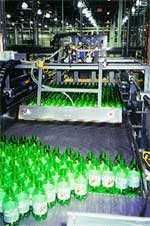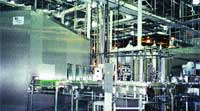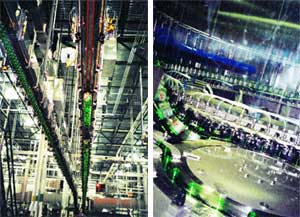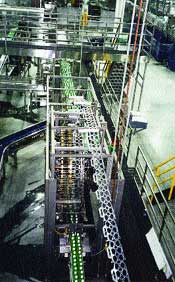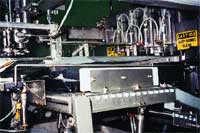In July, '02, the first products rolled off of the small-bottle PET line at the new $40-million, 200,00-sq-ft production/distribution plant of Pepsi Bottling Ventures LLC (PBV) in Raleigh, NC. By the end of the year, four packaging lines were producing 24 million cases, with the ability to increase production to 30 million cases by '10. The four lines, which produce more than 250 stockkeeping units, include a 12-oz can line running 1,600 cans/min, a 40-bottle/min 1-, 2- and 3-L PET line, a 1,100-bottle/min line running 12-, 16-, 20- and 24-oz and 500-mL PET bottles, and a 12-bag/min bag-in-box line.
PBV was created in '99 when PepCom Industries (owned by Japanese beverage conglomerate Suntory Intl.) combined with five PepsiCo-owned bottlers as part of PepsiCo's plan to consolidate its bottling network around a handful of anchor bottlers. PBV has bottling rights for Pepsi products covering the majority of North Carolina, as well as a portion of Long Island, NY. The Raleigh facility, along with a sister operation in the recently upgraded PBV production bottling plant in Winston-Salem, NC, replaced two older production plants in North Carolina.
A primary goal in constructing the new production facility in Raleigh was the production of bottled water under the Aquafina label, the fastest-growing product within the Pepsi family. Bottled water is also the fastest-growing product in the beverage industry within the U.S., and PBV needed its own high-speed production facilities to be competitive in a very cost-conscious market. New high-speed Aquafina production in Raleigh was a key ingredient to justify the $4-million expenditure in a new production plant.
Both Raleigh and Winston-Salem produce cold-filled carbonated and noncarbonated beverages, while hot-filled products are imported from other Pepsi bottling facilities or licensed copackers. In addition to Aquafina, other high-profile brand names produced in the two PBV facilities include Mountain Dew, Sierra Mist, Diet Pepsi, Lipton Brisk, Fruitworks, Dr. Pepper, Hawaiian Punch, Sunkist and Nugrape.
|
|
An automatic depalletizer, left, sweeps prelabeled bottles onto a mass-bottle conveyor that transports them to unscramblers. After rinsing, filling and capping, which takes place in a sanitary enclosure, above, bottles pass a level inspector followed by ink-jet and laser printers. |
Unique features of the new plant are individual sanitary enclosures, designed and manufactured by ICS Intl., that contain the washing/capping/filling systems on the PET lines. Conventional filling rooms in older beverage bottling plants were designed as one large room with sanitary finishes, high drainage capabilities and climate control systems for operation and cleanup. Reportedly, these older-style filling galleries are expensive to construct and keep clean. Also, since all the fillers are housed in one room, with a common heating, ventilating and air conditioning system, contamination of one filler could spread to the adjacent filling equipment.
The PBV plant features an individual sanitary enclosure for each filling system. "We chose ICS because they have the most expertise in free-standing clean room technology," says vp of engineering Scott Jamison. "They did a fantastic job of building the enclosures on-site, integrating the monobloc filler guards into the face of the enclosure. The filler literally became part of the enclosure"
The enclosures are designed with an epoxy floor, sloped to a stainless-steel drain, vision panels and a complete air-quality control system. The walls and ceiling are made of insulation sandwich panels consisting of inside and outside stainless-steel panels filled with polyurethane foam.
The enclosures are self-supporting structures, with modular panels to minimize the installation time and amount of civil engineering on-site. All piping and conduit openings through the roof and ceiling are properly sealed for the air tightness of the enclosure. The clean rooms come complete with lighting, doors, an air filtration unit, air conditioning, and an air exhaust system.
|
From the unscramblers, bottles supported by their neck rings are air-conveyed, left, to the rinsing/filling/capping system. Gripping heads on the rinser, right, turn bottles upside down before purified water is sprayed into them. |
The air-filtration units maintain pressure in the enclosure to prevent outside air from entering and provide 40 air changes/hr. They incorporate cooling coils to cool the temperature of the air in the summer. The units have three filtration stages: roughing filters, bag filters and HEPA filters for an average air quality of Class 1,000.
Exhaust air from the enclosure is normally discharged into the surrounding processing plant. However, to avoid discharging air loaded with sugar or ozone into the surrounding area inside the Pepsi plant, ICS added an air extractor that sucks the air from the enclosure and ducts it outside the plant.
|
Bottles on wide conveyor are split onto two smaller conveyors for transport to machine producing 6-packs. |
"Each enclosure is custom-designed to enclose the filling system as tightly as possible," says ICS sales manager Vincent Michel. "This limits the air volume around the filler, so the air quality can be optimized. The design also allows the operator to stand outside of the room and still control the machine."
High-speed, small-bottle PET line
During PD's visit, the the line was running 16-oz Mountain Dew. Prelabeled bottles, which are supplied by Amcor, are delivered to an automatic depalletizer on pallets with cardboard slipsheets between the layers. The depalletizer raises the pallet one layer at a time, and a sweep carriage equipped with suction cups swings over and automatically removes the slipsheet and deposits it in a bin for return to the bottle supplier. The depalletizer then indexes the layer of bottles up, and the carriage sweeps the bottles onto a mass bottle conveyor. Sentry Equipment supplied the depalletizers and all conveyors in the plant. The company also assisted PBV in the development of the packaging line layouts and controls.
The bottles on the small-PET line are conveyed in mass to two Lanfranchi high-speed bottle unscramblers, on which rotating turrets orient the bottles in an upright position. The plant requires two unscramblers to keep up with the line speed. Level sensors in the hopper of each unscrambler turn delivery elevators on and off to maintain bottles in the hoppers.
The bottles from both unscramblers converge in single-file and are injected into the neck-guided air-conveyance system, where the bottles are supported by rods beneath their neck finishes. Air blowing in the conveyor chamber pushes them along. The depalletizing workcell, which includes three depalletizers, is designed to allow two operators to feed containers to three production lines. The use of unscramblers is new to Pepsi and is a direct result of new and more-difficult-to-handle bottles. The unscramblers improved material handling with a reduction in labor.
Empty bottles are conveyed directly via air conveyor into the sanitary enclosure and the infeed star of the monobloc rinser/filler/capper. All bottle-handling within the monobloc is accomplished by supports under the neck rings of the bottles. An inherent benefit of this monobloc design is the need for only one transfer star between each pair of machines, rinser to filler and filler to capper, which greatly reduces bottle-handling problems.
The bottles are delivered to the gripping heads of the 108-station rinser through the entrance starwheel, and are turned upside down as the unit rotates. Purified water is sprayed into the bottles through nozzles affixed to the gripping heads, and then drains out as the unit continues its rotation. When running Aquafina, this solution includes ozone for maximum cleaning efficiency. Bottles are then turned upright and discharge through a starwheel that also serves as the delivery starwheel to the filler.
The filler for these bottles is an isobaric-volumetric machine with 144 filling valves. The rinser and filler were supplied by SIDEL. Each filling valve is connected to the central tank through a product pipe and two gas pipes connected to the carbon dioxide supply–one for the bottle pressurization and the other for the pressure stabilization between the tank and the filling valve. When running noncarbonated beverages, the system uses nitrogen rather than carbon dioxide. The level inside the filling cylinder is essentially the same as the level in the central tank, and changes in the quantity of fill for different bottle sizes is accomplished by changing the level in the central tank. A piston in each cylinder is adjusted by an external magnetic coupling to set the exact volume to be filled to an accuracy of ?2 mL. This is done from the operator panel.
To operate high-speed fillers for carbonated soft drinks, the final product must be cooled to a range of 35 to 50 deg F prior to filling to retain carbon dioxide in the product. To minimize the amount of ammonia in the total system, conserve space and increase cooling efficiency, each filler at PBV is equipped with a stainless-steel plate-and-frame heat exchanger that cools the product from 86 deg F to the final fill temperature required for that product. This system represents the latest in carbonated beverage technology. After cooling, the product is injected with carbon dioxide and is then filled into the bottles.
Each flavor change within the piping, tanks and fillers requires a cleaning and sterilizing process. Separate, automatic clean-in-place systems have been located at each filler, and a dual CIP system was installed for the batch system to reduce cleaning time. The necessary cleaning chemicals and cleaning cycles are controlled by an automatic control system that minimizes the total time required to clean the system and place it back into operation.
From the filler, bottles travel through another starwheel into the 36-head Arol CSD screw capper. Caps, which are supplied by Alcoa, are sorted and delivered to the capper by a system from SIDEL, Packaging Systems Div. Caps are loaded into a hopper located outside of the enclosure, from which a nearly vertical belt carries them to the top of the enclosure. Caps are contained on horizontal cleats on the belt, and improperly oriented caps fall back into the hopper. The belt discharges the caps onto a track that carries them down to the capper. A transfer star picks the caps from the track and places them on the capping head, which rotates synchronously above the bottle turret. As the unit rotates, the capping head lowers and screws the cap onto the bottle to a preset torque setting. Arol supplied the upper capping turret, including the capping head and the drive hub, to SIDEL, which assembled the monobloc system.
|
Continuous-motion case packer places four 6-packs of bottles into reusable plastic crates. The machine also packs 20-oz loose bottles into the plastic crates. |
Capped bottles leaving the enclosure pass through an Industrial Dynamics Filtec x-ray fill height inspector and then past two Videojet Excel ink-jet printers that print a freshness date on the bottle cap tamper ring. The plant has installed two of these units to provide redundancy in case one unit malfunctions. For added security, a Domino laser printer applies production codes and a freshness date to the bottle. After being coded, the bottles travel onto a multichain mat-top conveyor that slows their transport speed from 350 to 40 ft/min and accumulates the bottles from single-file to mass.
Carbonated soft drinks are cold-filled at 35 to 50 deg F, and the bottles will sweat and damage the packaging if not warmed up after filling and capping. Therefore, the bottles are delivered to an in-line bottle warmer, supplied by G.C. Evans, where hot water spraying from overhead nozzles raises them to ambient temperature. The warmer consists of a 10-ft-wide mat-top belt that transports them in bulk beneath the hot water sprays inside the chamber. The warmer automatically adjusts the water temperature based on the wet bulb temperature in the warehouse, thus optimizing the process while reducing energy costs.
Multiple casing options
The plant produces more than 250 skus, representing 40 different flavors, in various package combinations. From the warmer, finished products are diverted onto conveyors that carry them to machinery that can package bottles in multipacks or loose bottles.
A HiCone machine produces six-packs of 16- and 24-oz, and 500-mL bottles. The bottles are delivered to the machine in two lanes; it separates six bottles and applies the plastic carrier material. The material is delivered in a continuous web to a large vertical wheel rotating above the bottles. The wheel pushes the web down onto the six bottles, and it is then cut to separate the six-pack. The packs are then diverted into two lanes and fed to a Hartness 2650 continuous-motion case packer that places four six-packs into reusable plastic crates for delivery to the PBV warehouse for distribution. The plant also runs 20-oz loose bottles directly to the Hartness for packing into plastic trays.
Bottles can also be conveyed to a packing installation incorporating a Model MW7 multipacker and a Model TDL tray former/loader and shrink wrapper, all supplied by Douglas Machine. Each of these servo-driven machines has its own control panel, with intuitive touchscreen interfaces with real-time production data, maintenance scheduling and changeover settings.
Bottles, including 500-mL water and carbonated soft drinks and 12-oz water, are delivered to the multiwrapper, where groups of six or 12 bottles are wrapped in registered film. This is a dual-stream machine that wraps two parallel groups of bottles simultaneously. Bottles are delivered in mass to the machine and are separated into either six- or 12-bottle groupings by a proprietary pinless metering system. The groups are then delivered into the wrapping section. The film is placed around the bottle group, and the package is conveyed through a heated shrink tunnel.
Four six-packs or two 12-packs are then delivered to the tray former/loader. The machine forms a tray from a paperboard blank, pushes the wrapped packs onto the tray, and then seals the open sides with hot-melt glue applied by a Nordson glue system. These trays are not overwrapped; they are conveyed directly to the palletizers. Some 500-mL bottles, as well as 20- and 24-oz bottles of all products can bypass the multipacker and be delivered directly to the tray former/loader. After these are placed on the tray, it travels through a shrink wrapper/heat tunnel.
Once the products are packaged, they are conveyed past a Videojet ink-jet case coder for application of production codes and then overhead to an automatic palletizer supplied by T-Tek Material Handling, Inc. Each sku is individually palletized to a designed stacking pattern. Individual packages are delivered to the upper level of the palletizer and are assembled into layers. After each layer is completed, the platform lowers so the next layer can be assembled. Finished pallet loads discharge at floor level and are transported by pallet conveyor to an Orion stretch wrapper. PBV uses plastic pallets, which has improved palletizing efficiency and has eliminated the debris and floor damage traditionally caused by wood pallets.
|
Plastic carriers for 6-packs are delivered to the applicating machine in a continuous web. A vertical rotating wheel pushes the web down onto the bottles, and it is then cut to separate the 6-pack. |
Before deciding on the location of the palletizers, PBV had an analysis performed to compare placing the palletizers at the end of each line versus placing the palletizers in the warehouse and closer to the storage areas, as is done in most larger beverage warehouses.
The analysis showed that locating the palletizers in the warehouse, with the close proximity of doors and storage space, would save PBV 38,000,000 ft of travel distance during the full year, or an average hourly distance of 9,198 ft. This is the equivalent of at least one person and forklift per shift.
Finished products are stacked two or three high, without pallet racks, and are rotated by code dates. The warehouse has been designed to have twin-load pallet racks in the future that will accommodate four-high stacking. The forklifts are also responsible for placing empty pallets into the palletizers.
The plant was specifically designed to allow all raw materials and finished goods to be handled on double forklifts. These forklifts allow two pallets to be picked up at a time and greatly reduce loading and unloading time of the production equipment. The dock equipment was engineered to allow the movement of these extra-wide and heavy loads in and out of the building.
The double-fork trucks are also used to load trailers with finished products going to the sales centers, unload return trailers with empty plastic pallets and shells, store empty shells and pallets, and feed empty shells to the three lines. Double-fork trucks greatly reduce the number of forklifts and total travel distance in high-volume beverage plants.
More information is available:
Filler enclosures: ICS Intl., 450/582-9162. Circle No. 238.
Bottles: Amcor PET Packaging-North America, 905/275-1592. Circle No. 239.
Bottle depalletizers, air conveyors, tabletop conveyors and conveyor controls: Sentry Equipment, Inc., 434/525-0769. Circle No. 240.
Bottle unscramblers: Lanfranchi, 011/39-521-802-546. Circle No. 241.
Rinser, filler, capper assembly, monobloc: SIDEL, Inc., 770/449-8058. Circle No. 242.
Capper head: Arol S. p. A., 323/581-8755. Circle No. 243.
Cap feeder: SIDEL, Packaging Systems Div., 941/727-1400. Circle No. 244.
Caps: Alcoa Closure Systems Intl., 317/390-5000. Circle No. 245.
Level inspection: Industrial Dynamics Co., 310/325-5633. Circle No. 246.
Ink-jet printers: Videojet Technologies, 630/860-7300. Circle No. 247.
Laser printer: Domino Amjet, Inc., 708/244-2502. Circle No. 248.
Bottle warmer: G.C. Evans, 501/664-5095. Circle No. 249.
Pack system, carriers:ITW HiCone, 630/773-9300. Circle No. 250.
Case packer: Hartness Intl., Inc., 964/297-1200. Circle No. 251.
Multipacker, tray packer, shrink wrapper: Douglas Machines, 320/763-6587. Circle No. 252.
Glue system: Nordson Corp., 770/497-3715. Circle No. 253.
Palletizers: T-Tek Material Handling, Inc., 334/567-1005. Circle No. 254.
Stretch wrapper: Orion Packaging Systems, 901/366-4170. Circle No. 255.
Bag-in-box line runs 12 bags/min | ||
Bags are fed to the machine in a continuous web. The machine automatically draws the web out of the delivery box and separates a bag, which is then taken into the machine by the shuttle mechanism. The machine removes the cap from the bag, fills the syrup, and then replaces the cap. |
About the Author(s)
You May Also Like
